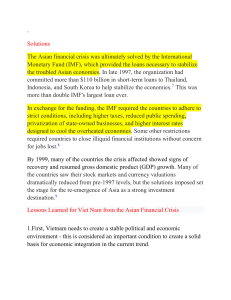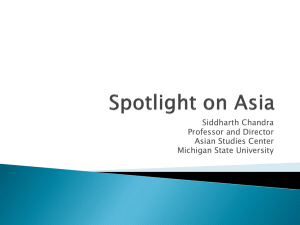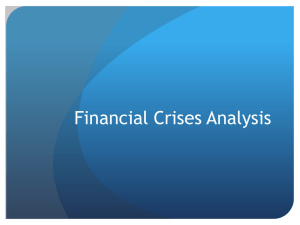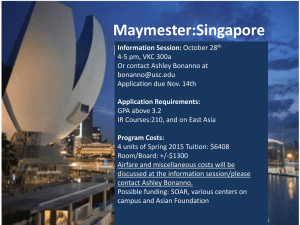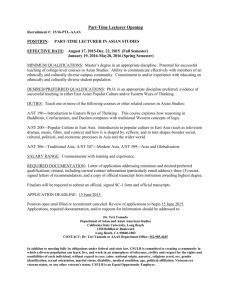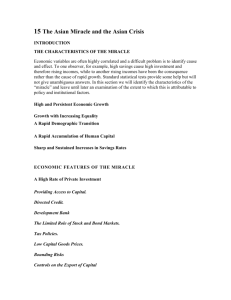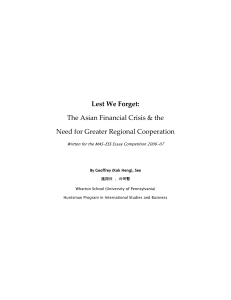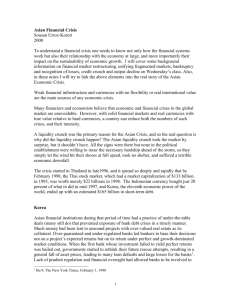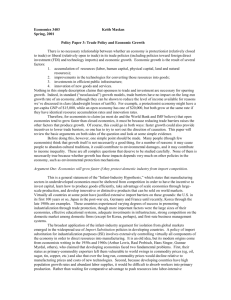Cause and Consequences of the Asian Financial Crisis, by Cregory W
advertisement
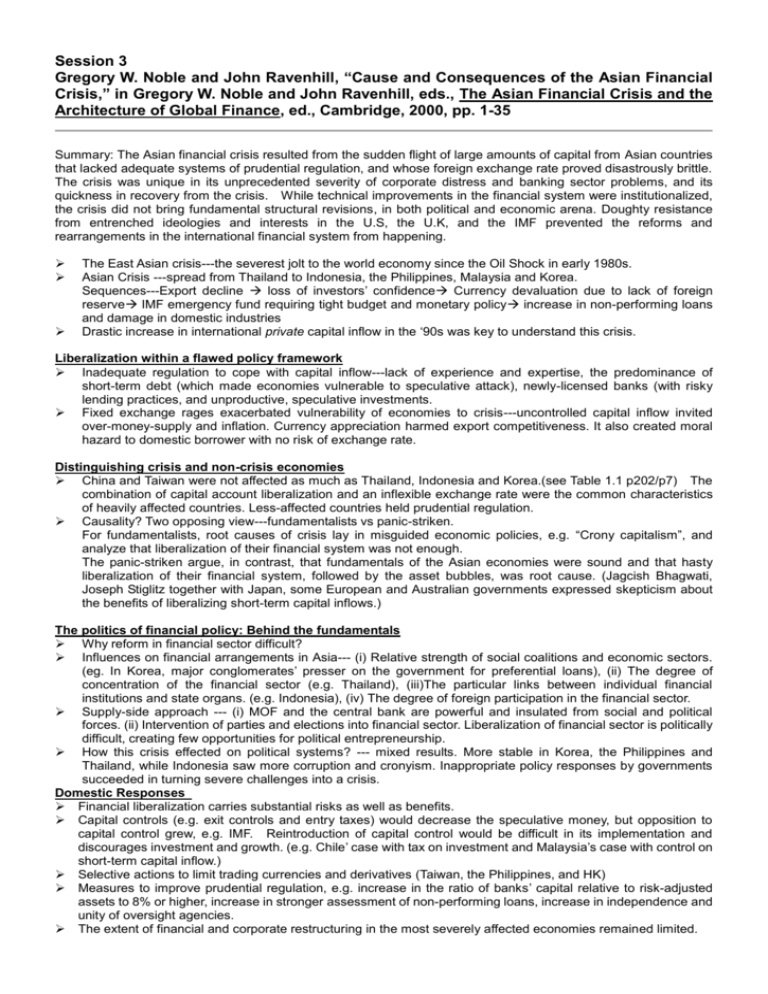
Session 3 Gregory W. Noble and John Ravenhill, “Cause and Consequences of the Asian Financial Crisis,” in Gregory W. Noble and John Ravenhill, eds., The Asian Financial Crisis and the Architecture of Global Finance, ed., Cambridge, 2000, pp. 1-35 Summary: The Asian financial crisis resulted from the sudden flight of large amounts of capital from Asian countries that lacked adequate systems of prudential regulation, and whose foreign exchange rate proved disastrously brittle. The crisis was unique in its unprecedented severity of corporate distress and banking sector problems, and its quickness in recovery from the crisis. While technical improvements in the financial system were institutionalized, the crisis did not bring fundamental structural revisions, in both political and economic arena. Doughty resistance from entrenched ideologies and interests in the U.S, the U.K, and the IMF prevented the reforms and rearrangements in the international financial system from happening. The East Asian crisis---the severest jolt to the world economy since the Oil Shock in early 1980s. Asian Crisis ---spread from Thailand to Indonesia, the Philippines, Malaysia and Korea. Sequences---Export decline loss of investors’ confidence Currency devaluation due to lack of foreign reserve IMF emergency fund requiring tight budget and monetary policy increase in non-performing loans and damage in domestic industries Drastic increase in international private capital inflow in the ‘90s was key to understand this crisis. Liberalization within a flawed policy framework Inadequate regulation to cope with capital inflow---lack of experience and expertise, the predominance of short-term debt (which made economies vulnerable to speculative attack), newly-licensed banks (with risky lending practices, and unproductive, speculative investments. Fixed exchange rages exacerbated vulnerability of economies to crisis---uncontrolled capital inflow invited over-money-supply and inflation. Currency appreciation harmed export competitiveness. It also created moral hazard to domestic borrower with no risk of exchange rate. Distinguishing crisis and non-crisis economies China and Taiwan were not affected as much as Thailand, Indonesia and Korea.(see Table 1.1 p202/p7) The combination of capital account liberalization and an inflexible exchange rate were the common characteristics of heavily affected countries. Less-affected countries held prudential regulation. Causality? Two opposing view---fundamentalists vs panic-striken. For fundamentalists, root causes of crisis lay in misguided economic policies, e.g. “Crony capitalism”, and analyze that liberalization of their financial system was not enough. The panic-striken argue, in contrast, that fundamentals of the Asian economies were sound and that hasty liberalization of their financial system, followed by the asset bubbles, was root cause. (Jagcish Bhagwati, Joseph Stiglitz together with Japan, some European and Australian governments expressed skepticism about the benefits of liberalizing short-term capital inflows.) The politics of financial policy: Behind the fundamentals Why reform in financial sector difficult? Influences on financial arrangements in Asia--- (i) Relative strength of social coalitions and economic sectors. (eg. In Korea, major conglomerates’ presser on the government for preferential loans), (ii) The degree of concentration of the financial sector (e.g. Thailand), (iii)The particular links between individual financial institutions and state organs. (e.g. Indonesia), (iv) The degree of foreign participation in the financial sector. Supply-side approach --- (i) MOF and the central bank are powerful and insulated from social and political forces. (ii) Intervention of parties and elections into financial sector. Liberalization of financial sector is politically difficult, creating few opportunities for political entrepreneurship. How this crisis effected on political systems? --- mixed results. More stable in Korea, the Philippines and Thailand, while Indonesia saw more corruption and cronyism. Inappropriate policy responses by governments succeeded in turning severe challenges into a crisis. Domestic Responses Financial liberalization carries substantial risks as well as benefits. Capital controls (e.g. exit controls and entry taxes) would decrease the speculative money, but opposition to capital control grew, e.g. IMF. Reintroduction of capital control would be difficult in its implementation and discourages investment and growth. (e.g. Chile’ case with tax on investment and Malaysia’s case with control on short-term capital inflow.) Selective actions to limit trading currencies and derivatives (Taiwan, the Philippines, and HK) Measures to improve prudential regulation, e.g. increase in the ratio of banks’ capital relative to risk-adjusted assets to 8% or higher, increase in stronger assessment of non-performing loans, increase in independence and unity of oversight agencies. The extent of financial and corporate restructuring in the most severely affected economies remained limited. Reforming the Global Financial Architecture Asian crisis led to bring various proposals of global financial reforms. The panic-striken called for the need for restrictions on speculative capital and cooperation on monetary affairs at the regional revel (Japan, Austria, and some European countries). But some argues that floating rates were not risk-free. Division between twin Washington-based institution---IMF and WB was deepened. Reforming IMF Calls for abolition of IMF---IMF is institutionalizing the moral hazard, and encourages speculators to undertake dubious investments. Need for greater transparency of IMF Criticism against conditionality by IMF during the Asian (tight fiscal policy during crisis, increase in interest rate and ill-times closure of financial institutions aggravated economic recession.) Huge debate over conditionality. Building the private sector in Criticism against private actors for not bearing the cost of crisis Regional Responses Proposal for establishing AMF (Asian Monetary Fund) by Japan and Taiwan, which was killed by the US opposition. This idea is unlikely to come true Bilateral programs by Japan (New Miyazawa Plan by the Export-Import Bank of Japan1) The crisis has drawn East Asian economies together, realizing that they do not have an effective voice in the governance of the monetary system. This led to the effort to establish a representational organization or regime, the outcome remains to be seen. 1 This is the organization I work for!!! (I did not have to include the Miyazawa Plan in this summary since this is too detailed info, but I wanted!)
